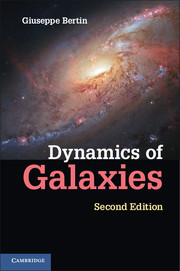Book contents
- Frontmatter
- Contents
- Preface to the Second Edition
- Preface to the First Edition, 2000
- Acknowledgments
- PART I Basic Phenomenology
- PART II Physical Models
- PART III Spiral Galaxies
- PART IV Elliptical Galaxies
- PART V In Perspective
- 25 Selected Aspects of Formation and Evolution
- 26 Galaxies and Gravitational Lensing
- 27 Self-Gravitating Accretion Disks
- Bibliography
- Index of objects
- Index
26 - Galaxies and Gravitational Lensing
from PART V - In Perspective
Published online by Cambridge University Press: 05 June 2014
- Frontmatter
- Contents
- Preface to the Second Edition
- Preface to the First Edition, 2000
- Acknowledgments
- PART I Basic Phenomenology
- PART II Physical Models
- PART III Spiral Galaxies
- PART IV Elliptical Galaxies
- PART V In Perspective
- 25 Selected Aspects of Formation and Evolution
- 26 Galaxies and Gravitational Lensing
- 27 Self-Gravitating Accretion Disks
- Bibliography
- Index of objects
- Index
Summary
This chapter is devoted to a very simple summary of the main concepts at the basis of gravitational lensing and its astrophysical applications, with special attention to the frequent case in which galaxies act either as lenses or as sources affected by the phenomenon of lensing. After the discovery of the first clear macroscopic evidence of gravitational lensing, that is, the observation of a double image of a single quasar produced by an intervening galaxy acting as a lens, enormous progress has been made in terms of observations and theoretical results, which has produced a vast literature dealing with a number of distinct and extremely interesting related topics. As we will see, the physical basis of gravitational lenses is such that the most spectacular phenomena are produced by distant lenses on very distant sources; this is why the rapid progress and growing interest in this subject largely coincide with the systematic exploration of the distant Universe at redshifts of cosmological interest started at the end of the past century.
The main reason to present such a summary here is that one of the most interesting themes developed in the past ten to fifteen years in relation to the general problem of mass diagnostics for galaxies and clusters of galaxies is that of the combined use of gravitational lensing and dynamics. The use of dynamics as a diagnostic tool to probe the mass distribution in galaxies and other systems is generally based on the assumption that the object under investigation has reached a state of approximate dynamical equilibrium.
- Type
- Chapter
- Information
- Dynamics of Galaxies , pp. 418 - 434Publisher: Cambridge University PressPrint publication year: 2014

